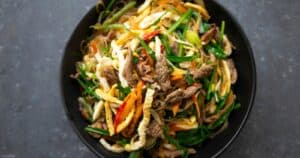Discover the mouthwatering flavors of Korean cuisine while staying in ketosis! Yes, you read it right – Korean food can indeed be keto-friendly. If you’re on a keto diet and worried about missing out on the deliciousness of Korean dishes, fret not!
In this blog post, we will explore the world of keto-friendly Korean food and provide you with some tantalizing options to satisfy your cravings.
Exploring Keto-Friendly Korean Dishes
Korean food can indeed be keto-friendly, offering a variety of delicious dishes that are low in carbs and high in healthy fats.
By making a few simple substitutions and adjustments, you can enjoy traditional Korean flavors while sticking to your keto diet. Here are some popular keto-friendly Korean recipes to explore:
Bibimbap: Swap out the rice in bibimbap and use cauliflower rice instead. Top it with sautéed vegetables, a fried egg, and your choice of sliced beef or tofu. Drizzle it with sesame oil and gochujang sauce for that extra burst of flavor.
Bulgogi: Make your bulgogi keto-friendly by using low-carb sweeteners like erythritol or stevia instead of sugar. Marinate the beef in this sauce for at least an hour, then grill or pan-fry until it’s cooked through.
Kimchi Stew: Kimchi stew is already packed with flavor and can be easily made low-carb. Use low-sodium broth and reduce the amount of salt. In a pot, sauté garlic and onions in oil, then add chopped kimchi, broth, and tofu. Let it simmer until the tofu is fully cooked. Serve with cauliflower rice for a satisfying meal.
Japchae: Enjoy the delicious Korean noodle dish, japchae, in a keto-friendly way. Use low-carb sweeteners like erythritol or stevia instead of sugar when cooking the sweet potato noodles. Sauté spinach, carrots, and mushrooms in oil, then add the cooked noodles and soy sauce. Toss everything together until well combined, and serve hot or cold.
Galbi: Transform galbi, a Korean-style short rib dish, into a keto-friendly delight. Swap out sugar for low-carb sweeteners in the marinade. Marinate the short ribs for at least an hour before grilling or broiling until they are perfectly cooked through.
By using low-carb ingredients and making smart substitutions, you can still enjoy the rich and diverse flavors of Korean cuisine while following your keto lifestyle. These recipes are easy to make, filling, and full of authentic Korean taste.
Modifying Classic Korean Dishes for a Keto Lifestyle
Modifying classic Korean dishes for a keto lifestyle is completely doable with just a few simple swaps and adjustments. By making these changes, you can still enjoy delicious Korean flavors while sticking to your keto goals. Here are some ideas to help you modify classic Korean dishes:
Bibimbap: Bibimbap is a popular Korean rice dish, but you can replace the rice with cauliflower rice or zucchini noodles to reduce the carb content. Load up on low-carb vegetables like spinach, mushrooms, and bean sprouts. Top it off with a protein source like grilled chicken or beef. Opt for a low-carb sauce or gochujang without added sugar.
Bulgogi: Bulgogi is a savory and sweet grilled beef dish. To make it keto-friendly, choose lean cuts of beef and marinate them in a keto-friendly sauce made with low-carb sweeteners like erythritol or stevia instead of sugar. Serve it with a side of low-carb vegetables or a salad to complete your meal.
Kimchi Stew: Kimchi stew is a flavorful and spicy Korean dish. To make a low-carb version, use low-sodium broth and add low-carb vegetables like zucchini, mushrooms, and spinach. Consider adding protein sources like tofu or thinly sliced beef. Adjust the seasoning to reduce sodium content if needed.
Japchae: Japchae is a stir-fried noodle dish. To make it keto-friendly, use low-carb sweeteners instead of sugar in the sauce. Replace sweet potato noodles with low-carb alternatives like shirataki noodles or zucchini noodles. Load up on low-carb vegetables and add protein sources like shrimp or thinly sliced beef.
Galbi: Galbi is marinated and grilled beef ribs. For a keto version, choose lean cuts of beef and marinate them in a keto-friendly sauce using low-carb sweeteners. Grill or broil the meat and serve it with a side of low-carb vegetables or a salad.
Enjoying the Versatility of Korean BBQ on a Keto Diet
Korean BBQ can be a great option for those following a keto diet. To fully enjoy the flavors while staying within your carb limits, there are some tips and ideas to keep in mind.
Firstly, stick to plain meats or seafood without marination, as many Korean BBQ marinades contain sugar and carbs. Opt for lean cuts of beef, pork, or chicken, or choose seafood like shrimp or squid. This will help you avoid unnecessary sugar and carb intake.
Next, use low-carb sauces to add flavor to your meats. Gochujang or soy sauce with no added sugar can be great options. These sauces will enhance the taste of your meats without adding extra carbohydrates to your meal.
Instead of rice or noodles, try swapping them out with low-carb alternatives like cauliflower rice or zucchini noodles. These options are keto-friendly and can provide a similar texture and taste to traditional rice or noodles.
In Korean BBQ, there are often side dishes that can be low in carbs. Load up on low-carb vegetables like kimchi, spinach, mushrooms, and bean sprouts. These side dishes will not only add variety to your meal but also provide essential nutrients while keeping your carb intake in check.
If you want to enjoy marinated meats, make your own keto-friendly marinades using low-carb sweeteners like erythritol or stevia instead of sugar. This way, you can have the flavors you love without compromising your keto diet.
Lastly, choose fatty cuts of meat like beef short ribs or pork belly. These cuts are high in healthy fats and low in carbs, making them a perfect choice for those following a keto diet.
Kimchi: A Keto-Friendly Condiment for Flavor and Health
Kimchi is a traditional Korean fermented vegetable dish that offers both flavor and health benefits. It is also a keto-friendly condiment that can be enjoyed as part of a low-carb diet. With its low carbohydrate content and abundance of probiotics and prebiotics, kimchi can be a valuable addition to your meals.
One of the key attributes of kimchi is its low-carb nature. With only 2 grams of net carbs per 1-ounce serving, it fits well within the constraints of a ketogenic diet. This makes it a suitable choice for those looking to reduce their carbohydrate intake while still adding a burst of flavor to their meals.
The ingredients used to make kimchi are natural and wholesome. Napa cabbage, daikon radish, green onions, garlic, ginger, and Korean red pepper powder (gochugaru) are common components of kimchi. These ingredients not only contribute to the delicious taste of kimchi but also offer various health benefits.
One notable advantage of consuming kimchi is its abundance of probiotics and prebiotics. Probiotics are live bacteria that are beneficial for gut health, while prebiotics are a type of fiber that fuels the growth of these beneficial bacteria. The combination of probiotics and prebiotics in kimchi helps promote a healthy gut and immune system.
In addition to being a standalone dish, kimchi can be used as a condiment or ingredient in a variety of dishes. It adds a tangy, spicy kick to stir-fries, soups, stews, and salads. This versatility allows you to incorporate kimchi into your meals in exciting and creative ways, enhancing both the flavor and nutritional value of your dishes.
Making kimchi at home is also a simple and customizable process. You can adjust the flavors and spices to suit your taste preferences. By using low-carb sweeteners like erythritol or stevia instead of sugar, you can easily make kimchi that aligns with the requirements of a keto diet.





